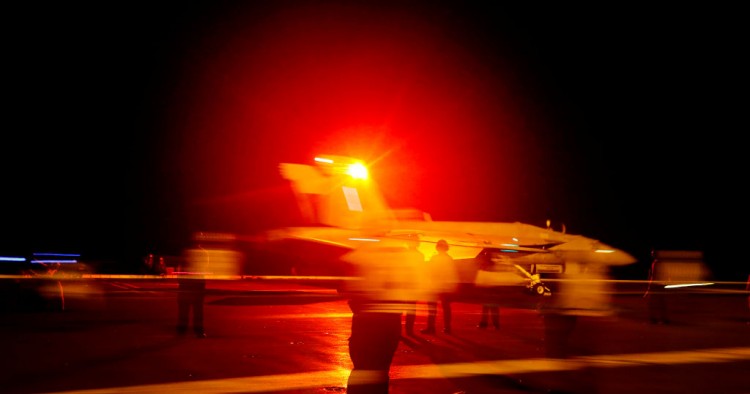Since the Trump administration refused to extend waivers for Iranian oil exports expiring on May 2nd, the U.S. and Iran have engaged in a cycle of escalating threats and actions. In response to the U.S. move to tighten oil sanctions and push Iranian oil exports “to zero,” Iranian Foreign Minister Javad Zarif used a visit to New York in late April to highlight both publicly and privately Iran’s determination to resist the U.S. pressure and retaliate if pushed to the brink.
Zarif told an audience at the Asia Society, on April 24, that Iran would continue to sell its oil despite the U.S. sanctions and warned that the U.S. “should prepare for the consequences” if it tries to block Iranian sales. Moreover, Zarif alleged that the so-called “B Team” of John Bolton, Benjamin “Bibi” Netanyahu, Mohammed bin Salman (MbS), and Mohammed bin Zayed (MbZ) was trying to “push the U.S. toward disaster” despite President Donald Trump’s campaign pledge to avoid further foreign conflicts.
In private meetings, Zarif stuck to his aggressive public pose. He reiterated his view that President Trump sees the U.S. “maximum pressure” campaign as his leverage to force Iran to return to the negotiating table. But the B Team hard-liners, in Zarif’s estimation, want to corner Trump and use that pressure to provoke a conflict. Zarif vowed that Iran will not accept “being bled to death.” If pushed too far, it will retaliate — first of all against the Saudis and Emiratis, who he believes are overly confident in their own military capabilities. He speculated that a war might start over a “planned accident” that could be blamed on Iran.
Since Zarif’s visit, tensions have been raised even higher. The U.S. has further ratcheted up its maximum pressure on Iran by adding new sanctions on its export of iron, steel, aluminum, and copper. Industrial metals are Iran’s second-largest export earner after oil and gas. And in the last few days, the turmoil has deepened as the region absorbed reports of mysterious sabotage against tankers in Emirati ports, apparent Houthi drone attacks on Saudi oil facilities, and news that the Trump administration is contemplating substantial deployments of U.S. military personnel to the region to deter potential attacks against U.S. interests while ordering hundreds of “non-essential” staff to depart the embassy in Baghdad.
Does all of this saber rattling suggest that the drift toward a conflict with Iran is imminent or irreversible? Probably not. Most importantly, none of the immediate parties to the dispute likely sees an open conflict to be in its interests now:
-
Despite its recent air and naval deployments to the region, the U.S. does not currently have in place the assets that the military would demand for more than a limited kinetic response. But decades-long experience in Iraq and Syria makes clear that such limited campaigns do not lead to significant political results. President Trump acknowledged that, should the administration decide to enhance its military posture in the region, "we’d send a hell of lot more troops than” the 120,000 personnel being reported. Moreover, European reactions to the escalating tensions in the Gulf make clear that the U.S. would be operating without significant buy-in from its allies. Trump himself is reported to be hitting the brakes on talk of conflict with Iran.
-
For his part, Foreign Minister Zarif made clear that Iran is also intent on avoiding a conflict in the region. He acknowledged in remarks in a private meeting that the Iranians may have exaggerated their military capabilities. The Iranians understand that, regardless of the ultimate outcome of a conflict with the U.S., they would inevitably suffer the consequences of the fight. Perhaps with that in mind, Iranian Supreme Leader Ayatollah Ali Khamenei has also downplayed the threat of a U.S.-Iran conflict. He told senior officials that “Neither we, nor them is seeking war,” according to the state-run IRAN newspaper. Although Khamenei also described the prospect of negotiating with Trump as “poison,” it remains uncertain that the Iranians would not agree to return to the negotiating table if the circumstances favor it.
-
Finally, the Saudis and Emiratis have been relatively circumspect in their response to the incidents in Fujairah and the attack on the Saudi pipeline. Despite Zarif’s assertion that MbS and MbZ are part of the B Team, the indications all point to Saudi and Emirati reluctance to be dragged into a shooting war with Iran. The Saudi response to the Houthi drone attack was predictable, but didn’t go beyond its past practice. Even without Zarif’s explicit warnings in New York, possibly reinforced by the sabotage and drone attacks of recent days, the Gulf leaders well understand that their cities and oil facilities would be prime targets for Iranian retaliation in the case of conflict.
Of course, the fact that none of the principal players in the recent round of escalation wants to see it lead to a conflict doesn’t mean that the threat of open warfare is off the table. Tit-for-tat escalation brings its own threat that miscalculation or misunderstanding can trigger a broader confrontation and an outbreak of fighting. As the U.S. expands its military footprint in the region, the risks of that kind of accidental war will rise. Thus, it’s important for the players to take steps in the coming days to lower the temperature and reverse the escalatory cycle.
Amb. (ret.) Gerald Feierstein is MEI’s senior vice president. The views he expresses are strictly his own.
Mass Communication Specialist Seaman Michael Singley/U.S. Navy via Getty Images
The Middle East Institute (MEI) is an independent, non-partisan, non-for-profit, educational organization. It does not engage in advocacy and its scholars’ opinions are their own. MEI welcomes financial donations, but retains sole editorial control over its work and its publications reflect only the authors’ views. For a listing of MEI donors, please click here.













